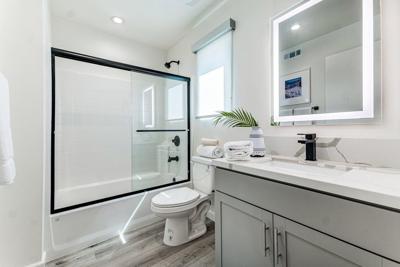
One of the best home improvements you can make is to renovate your bathroom. It will make your daily life better and increase the value of your home when you sell it. But if you don't have a good plan, the process can quickly get out of hand, cost a lot of money, and take a long time. You can make sure your project stays on budget and gives you the spa-like retreat you want by following a structured, step-by-step plan.
1. Figure out what you need, what you want, and how much money you have.
The first and most important step is to make sure you know what the job entails and set a reasonable budget.
Take a look at your current space: Figure out what needs to be fixed (like leaks or bad ventilation) and what you just want to change (like old tiles or a new layout). Make two lists: "Must-Haves" (like more storage or better lighting) and "Wish-List" (like a freestanding tub or a double vanity).
Set a Budget: Be honest about how much you can spend, and then set aside an extra 15–20% for emergencies. When you remodel your bathroom, you might find plumbing or structural problems that you didn't know about. This buffer is important to keep you from getting stressed. Your budget will be the most important factor in whether or not you can change the layout. Moving the plumbing (toilets, drains) is the most expensive part of a renovation.
Identify Users: Is this going to be a busy family bathroom, a quiet master bathroom, or a simple guest bathroom? This affects the materials you choose (durability vs. luxury) and how much space you need to store things.
2. Finish the layout and flow
Even if you're not moving big things, making the most of the space is important for it to work.
Measure Everything: Make a detailed floor plan that shows where the doors, windows, and pipes are already located. Use graph paper or a digital tool to plan where all the fixtures will go, making sure there is enough space around the shower and toilet for people to move around comfortably.
Accessibility should come first: Make sure the vanity is easy to get to when you walk in, and the toilet is hidden away, preferably not the first thing you see.
Choose Fixtures Wisely: If your bathroom is small, think about wall-mounted toilets and vanities to save floor space. If you want a seamless, open look, go with a curbless shower.
3. Choosing Finishes: The Little Things That Make a Style
This is the fun part, when your idea becomes a reality. Because bathrooms are wet places, you should choose materials that are both beautiful and long-lasting.
Choose tiles for your floors that are water-resistant and have a good grip. People like large-format tiles (30x60 cm or bigger) because they have fewer grout lines, which makes cleaning easier. If you want luxury without the work, think about porcelain that looks like marble.
Lighting: Plan a layered lighting scheme that includes task lighting around the mirror, general ambient lighting, and accent lighting, like lights in a shower niche.
The taps, mixers, and showerheads are the bathroom's jewelry. Brassware that is both stylish and high-quality can instantly make a room look better. Look for a brand like Meir Taps, which is known for its simple, architectural designs and unique finishes like Matte Black, Tiger Bronze, or Champagne. If you use the same finish and style from one collection for your basin mixer, shower rose, and bath spout, they will all match perfectly, giving the whole design a polished, professional look.
4. Hire Experts and Keep Track of Time
The people who do the work on a renovation are what make it good.
Get Quotes: Get at least three detailed quotes from well-known builders or bathroom experts. Check their references and look at their past work, paying special attention to how well they tiled and waterproofed.
Contract and Schedule: Make sure your contract has a clear list of tasks, a payment schedule, and an estimated time frame. Depending on how much structural work needs to be done, a full renovation can take anywhere from 4 to 8 weeks. Clearly explaining the order of work—demolition, plumbing and electrical rough-in, waterproofing, tiling, painting, and finally fixture installation—will help people know what to expect.
By spending time on these four planning steps, you can make sure that your bathroom renovation goes smoothly, with fewer unexpected costs and delays, and that the end result is a beautiful, functional space that meets your needs for years to come.




(0) comments
We welcome your comments
Log In
Post a comment as Guest
Keep it Clean. Please avoid obscene, vulgar, lewd, racist or sexually-oriented language.
PLEASE TURN OFF YOUR CAPS LOCK.
Don't Threaten. Threats of harming another person will not be tolerated.
Be Truthful. Don't knowingly lie about anyone or anything.
Be Nice. No racism, sexism or any sort of -ism that is degrading to another person.
Be Proactive. Use the 'Report' link on each comment to let us know of abusive posts.
Share with Us. We'd love to hear eyewitness accounts, the history behind an article.